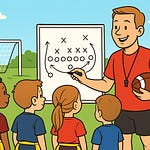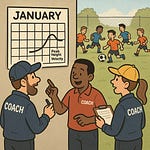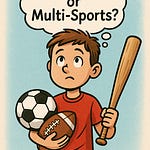During COVID, several researchers turned to surveys or interviews due to the constraints. Our research group from Leeds Beckett Carnegie School of Sport also took advantage of this methodology to learn more about the knowledge, adherence, practices, and challenges of practitioners related to youth motor skill competence and long-term athletic development (LTAD). This Audio Overview synthesizes the insights from three survey studies. Links to the original papers are found at the end of this post. Below you will also find some of the key themes and findings from this research as well. Listen, learn and enjoy.
Key Themes and Findings
1. Importance of Motor Competency and Long-Term Athletic Development (LTAD)
Integral to Youth Development: Motor competency is defined as "one’s ability to perform goal-directed tasks which require controlled and coordinated movement of the human body" (Burton et al., 2021, p. 2649) and is "integral to the long-term athletic development of youths" (Burton et al., 2021, p. 2649). It is multidimensional, encompassing simple (e.g., balance), combined (e.g., agility), and complex (e.g., hand-eye coordination) movement capacities (Burton et al., 2021).
Positive Trajectories: Enhanced motor competency in childhood is positively associated with physical activity levels, musculoskeletal strength and endurance, cardiorespiratory endurance, and inversely related to unhealthy weight status (Burton et al., 2021). It is crucial for "enhancing health, reducing injury risk, reducing obesity, increasing athleticism, increasing confidence and competence, and enhancing physical activity" (Burton et al., 2021, p. 2650).
"Proficiency Barrier": Limited motor competency foundations can lead to a "proficiency barrier," resulting in reduced motor competency, physical activity, and physical fitness in adolescence and adulthood (Burton et al., 2021, citing Seefeldt, 1980; Stodden et al., 2009).
LTAD Definition: LTAD is defined as the "habitual development of athleticism over time to improve health and fitness, enhance physical performance, reduce the relative risk of injury, and develop the confidence and competence of all youth" (Till et al., 2022, p. 2, citing Lloyd et al., 2016).
2. Perceptions vs. Practices of S&C Coaches and PE Teachers
General Alignment on Broad Importance: Both S&C coaches and PE teachers perceive a broad range of motor competencies as important across all stages of development (Burton et al., 2022). The most important competencies perceived by S&C coaches include "deceleration" (99%), "acceleration" (99%), and "hip hinge (bilateral)" (99%) (Burton et al., 2021, Table 1).
Disconnect in Practice:S&C coaches rated greater importance to linear speed and agility competencies (e.g., reacceleration, turning), but targeted more resistance training competencies (e.g., upper body pushing and pulling) in their practices (Burton et al., 2021, p. 2655).
The "most important competencies (except 'hip hinge [bilateral]')" ranked lower in practice than some recognized resistance training and plyometric competencies (Burton et al., 2021, p. 2655). This "disconnect between S&C coaches’ perceptions and practices when developing motor competency in youths" suggests coaches "don’t target what they perceive is important" (Burton et al., 2021, p. 2655).
Underestimation of Foundational Skills: Common Fundamental Movement Skills (FMS) (e.g., galloping, cartwheel) and foundational movement skills (e.g., cycling, swimming) were reported as the least important motor competencies to develop by S&C coaches (Burton et al., 2021, p. 2655). This oversight could lead to reduced motor proficiency later in development.
Strength-Based Competencies Overlooked Early On: Neither PE teachers nor S&C coaches rated strength-based competencies (e.g., lower-body bilateral/unilateral, upper body pushing/pulling, core bracing) as important during early stages of maturity (childhood, pre-PHV) (Burton et al., 2022). PE teachers rated them significantly less important than S&C coaches during childhood and pre-PHV (Burton et al., 2022).
Myths and Misconceptions: Qualitative responses revealed "myths/misconceptions" among PE teachers regarding "Risk of injury or stunted growth" from early strength training (Burton et al., 2022, Table 3, p. 14). This directly contradicts evidence suggesting that risks are no greater than everyday activities (Burton et al., 2022).
PE Teachers vs. S&C Coaches: S&C coaches generally perceived more motor competencies as important than PE teachers across all stages of maturity (Burton et al., 2022). This might be due to PE teachers being "bound by a curriculum" that may not prioritize a full range of competencies, while S&C coaches have "more freedom and subjectiveness" (Burton et al., 2022, p. 15).
If youth are only exposed to PE, they "may only develop a limited range of motor competencies," potentially leading to reduced MC, fitness, and physical activity later in life (Burton et al., 2022, p. 15).
PE teachers rated "balance" and "foundational movements for life" more important than S&C coaches across various maturity stages, especially post-PHV (Burton et al., 2022, Fig 3B, 3D).
3. Knowledge and Adherence to LTAD Principles
Recognition of Responsibility: Practitioners largely recognized their responsibility for developing health and fitness (96.1%), physical performance (91.4%), confidence and competence (97.0%), and reducing injury risk (93.5%) in youth (Till et al., 2022).
Inconsistent Definitions of "Athleticism": Practitioners' definitions of athleticism were "mixed, and often unidimensional in nature predominantly focussed upon physical domains" (Till et al., 2022, p. 10). Only 2.7% identified all four components (movement ability, physical qualities, psychological components, multiple environments), and just 2.0% included a "psychological element (i.e., confidence and competence)" (Till et al., 2022, p. 10).
Inconsistent Definitions of "LTAD": Definitions of LTAD were "highly variable amongst practitioners" (Till et al., 2022, p. 10), with questions raised about a focus on the 'athlete' over the 'individual'. This suggests a need for "a common consensus on long-term athletic development terminology" (Till et al., 2022, p. 11).
Familiarity with Models: Practitioners were more familiar with older models like LTAD and YPD compared to the more recent NSCA Ten Pillars (Till et al., 2022, Table 4). This could indicate reliance on "older models based on previous education and experiences" (Till et al., 2022, p. 11).
Self-Reported High Adherence (with caveats): Practitioners reported high adherence to the NSCA Ten Pillars (median score of 4 or 5), particularly Pillar 5 (health and wellbeing) (Till et al., 2022, Table 5). However, this might be influenced by "social desirability bias" (Till et al., 2022, p. 11), and further research is needed to verify actual practices.
Lowest Adherence Pillars: The lowest scoring pillars for adherence were:
Pillar 1: "highly individualized and non-linear nature of the growth and development of youth."
Pillar 8: "relevant monitoring and assessment tools."
Pillar 9: "systematically progress and individualize training programs." These represent "the greatest challenge to implementation" as they relate to scientific principles of paediatric exercise and training science (Till et al., 2022, p. 11).
4. Practical Challenges and Barriers
Governance and Priorities: A "significantly over-competitive environment" with a "focus of systems and programmes on particular sports" exists, where "other sports are seen as competition" (Till et al., 2022, p. 8). Some practitioners are driven by "personal gain" and "winning" rather than individual development (Till et al., 2022).
Resources: Limited "time" and a "number of athletes" (e.g., "classes of 30+ students, 5 times a day") make individualized training and monitoring difficult (Till et al., 2022, p. 8). "Inconsistent attendance" also limits development (Till et al., 2022).
Education: A "lack of knowledge" among some practitioners, or a belief that "this responsibility rests with other departments," hinders LTAD implementation (Till et al., 2022, p. 8). Sport's greater emphasis on technical/tactical development can misalign with LTAD (Till et al., 2022).
Early Specialization: Multi-sport participation is "not encouraged" in some environments, leading to "early specialisation" even for youth who could benefit from a broader range of motor skills (Till et al., 2022, p. 8). This can result in overuse injuries, as seen in racket sports (Till et al., 2022, p. 9).
High Training Volumes: Youth participating in multiple sports can face "excessive workloads" and "inadequate rest and recovery," creating "organised chaos" (Till et al., 2022, p. 9).
Staff Communication: Lack of communication among staff teams ("very rarely do strength and conditioning professionals and coaches talk about periodization and training loads") leads to "difficulty to monitor" and inconsistencies (Till et al., 2022, p. 9).
Parents: Parents "don’t think this is important, all they want is immediate success" (Till et al., 2022, p. 9), highlighting a need for parent education.
Youth Motivation: "The reality of motivating youth to participate in such activities is difficult," with "an alarming percentage of youth have little to no connection with physical activity outside of school" (Till et al., 2022, p. 9).
5. Recommendations for Optimization
Coach/Teacher Education:Target "misunderstandings around the risks of strength-based activity during early stages of maturity and the benefits of developing strength-based motor competencies across youth populations" (Burton et al., 2022, p. 2).
Develop and promote a "common consensus on long-term athletic development terminology" (Till et al., 2022, p. 11).
Disseminate "up-to-date and evidence-based models" beyond traditional ones (Till et al., 2022, p. 11).
Reflection on Practices: S&C coaches should "reflect on their practices to ensure these are appropriate for their athlete’s/individual’s needs," especially regarding the disconnect between perceived importance and actual practices (Burton et al., 2021, p. 2655).
Increased Session Frequency: Coaches delivering 3-4 sessions per week "targeted 15–18% more motor competencies" than those delivering 2 or fewer sessions per week. Coaches with less contact time should "seek other opportunities (outside of scheduled sessions) to target motor competencies which receive less focus" (Burton et al., 2021, p. 2656).
Holistic Approach & Varied Programs:Focus on "transferable competencies rather than individual skills," utilizing approaches like Athletic Motor Skill Competencies (AMSC) which combine force production/absorption with core stability for athletic tasks (Burton et al., 2021, p. 2656).
Embrace "microdosing" (low volume, high frequency) outside of scheduled sessions (Burton et al., 2021, p. 2656). The RAMPAGE (raise, activate, mobilise, prepare, activity, games, evaluate) framework can help integrate a broad range of MCs into warm-ups and sessions (Burton et al., 2021; Till et al., 2022).
Encourage "multi-sport and multi-activity participation" to develop "well rounded athletes" and reduce burnout (Till et al., 2022, p. 7).
Individualization and Monitoring:Implement "individual development plans" and adjust training based on individual needs and maturity status (Till et al., 2022).
Utilize "relevant monitoring and assessment tools" (Till et al., 2022, Table 1), including "fitness testing," "movement screens," "growth and maturity assessments," and "wellbeing using standardised questionnaires" (Till et al., 2022, p. 7).
Longitudinally track motor competence from "process (technique) and product (outcome) perspective" to understand individual needs (Burton et al., 2022, p. 17).
Stakeholder Collaboration: "Multiple organisations and practitioners need to work collectively" (Till et al., 2022, p. 13). This includes PE teachers and S&C coaches collaborating to integrate S&C principles into the PE curriculum (Burton et al., 2022).
Policy Review: Youth sport pathways and governance should be questioned, moving away from a "talent only" strategy and prioritizing the "health and wellbeing of the child" (Till et al., 2022, p. 2, citing Lloyd et al., 2016).
Note: Podcast and Notes created by Notebook LM.
Links to the original papers
Burton, A. M., Eisenmann, J. C., Cowburn, I., Lloyd, R. S., & Till, K. (2021). "Developing motor competency in youths: Perceptions and practices of strength and conditioning coaches." Journal of Sports Sciences, 39(23), 2649-2657.
Burton, A. M., Eisenmann, J. C., Cowburn, I., Lloyd, R. S., & Till, K. (2022). "Youth motor competence across stages of maturity: Perceptions of physical education teachers and strength and conditioning coaches." PLOS ONE, 17(11), e0277040.
Till, K., Lloyd, R. S., McCormack, S., Williams, G., Baker, J., & Eisenmann, J. C. (2022). "Optimising long-term athletic development: An investigation of practitioners’ knowledge, adherence, practices and challenges." PLOS ONE, 17(1), e0262995.











